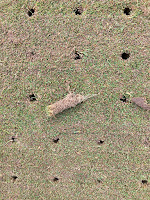I won't go into much details of the case, it was a slip and fall, and wasn't one of those termed "frivolous" lawsuits, really from what I saw as our charge as jurist, I don't think "frivolous" lawsuits make it to court, or have a very good chance of winning. But I digress. Why I mentioned the jury duty at all was, I was able to learn some things, one is I need to become an expert at something, those expert witnesses make good money, the other was, I wanted to touch on some things I learned that might be helpful by taking it back to my facility.
I first must thank my fellow staff members who prepared the course for one of our major events we have every season, our Horton Smith Junior Masters Tournament. We received many compliments from players to parents on course conditions and our landscaping. I had our new landscape intern concentrate on cleaning up tee beds and our score board area. Explaining that with the parents just riding around in carts watching, they would have plenty of time to scrutinize the peripheral items, while the players were more concerned with course conditions. I would just have time during the 3 days of the trial to come in the evening a check on progress, set irrigation and assign the next day's chores on our board. Obviously we had done some good communicating and training of our mostly seasonal staff, (who are all new this year), because the results were stellar.
Our score board area with the hardware waiting to be awarded. (I have some great before (or maybe in progress) and after pictures of this area I will share at a later date. We've been very lucky to find a plant science intern who has done some tremendous work on our landscaping this season)
Below a couple of pictures of the boss checking out her friends who had come out to play. It is an enjoyable time to be out on the course at that time of day, especially when the to do list was completed by the staff earlier.

But that doesn't mean we can't get better at this, as I listened to testimony on how one of the parties handled their training, orientations, and reinforcement, and I saw where we could improve. The main issue we lack with in is orientation and training. It is because we are a small crew with a lot going on, we tend to take our new employee out on a new task, spend not a lot of time training on the piece of equipment, whether it be raking bunkers, or mowing tees, or some other task we teach our new employees. We show how the equipment works, how we mow or rake the area, and put them on it, and watch and coach for a few holes. Then the trainer is off to work on his scheduled task for the morning. Sometimes we will try to be doing a task that will keep us in their areas, so they can ask any questions they might have and to correct any mistakes early. But it doesn't always happen like that. We also fail the first time to teach cleaning and some operational aspects of using the equipment, such as what our standard of clean is, and the failure to throttle the mower down before shutting it off trick. We lack consistency, and it will sometimes depend on who is doing the training that day, or for example I have even caught myself, forgetting a step or two when training, mainly because I know exactly how to do the task, yet the employee has failed to read my mind, (which happens a lot!).
So in the future I will be working on a detailed checklist to help the trainers not forget items. I also will look into something I started during a course I did a grow-in at. I actually tracked the training process, and then kept track of the progress made at learning the task, to a point that when they are able to do that task so many times, they will become "certified" on that task and piece of equipment.
As far as the reinforcement lesson I learned, it will be continuous, from their first day until their last, just a constant reminder of doing those little things such as picking up trash, making sure clippings are scattered, no tire tracks in the bunkers, basically asking them would they "like to play from that spot?"
So despite the compliments we get, and for which our staff should be so proud of, we will continue to try and get better. I would think we owe it to our seasonal staff, (who are mostly students) and to their next employer to create the best employees we can. Who knows, maybe they get the chance to come work for us?
Thanks again for reading!
Mel


































